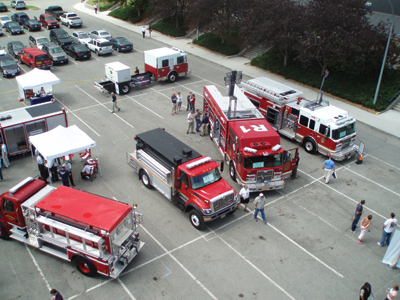
News
Shows must go on
CURRENT ISSUE
Shows must go on
As we head into trade-show season, Fire Fighting in Canada looks at the impact of the sagging economy on the annual exhibitions and conferences.
April 21, 2009
By James Careless
 |
|
|
|
Economic woes notwithstanding, the firefighting trade show season is here. As always, trade shows are being held in conjunction with spring and summer conferences planned by the fire chiefs associations across Canada.
But with the economy in the tank and chiefs fearful of budget cuts, trade show organizers and vendors worry about attendance while departments worry about justifying the costs of sending purchasing officers, training officers, chiefs and deputies to these annual events.
Like the medieval trade fairs from which they have descended, today’s trade shows allow buyers to see a range of
cutting-edge products in one place. In the firefighting industry specifically, “trade shows offer a great opportunity for fire departments to reduce their workload,” says Barry Malmsten, the OAFC’s executive director.
“In one location they can do direct comparison shopping. They can see, touch and learn about new products. They can get answers to their questions about existing products; they can discuss face to face with company representatives to resolve issues with their existing equipment, products or apparatus; and they get a chance to compare notes and learn from their peers from other fire departments.”
But it takes money for buyers to attend trade shows and vendors to exhibit at them. In today’s tough economy, organizers wonder if departments will find enough cash to keep the shows alive.
■ A financial perfect storm
When municipal funding dwindles, fire departments receive less cash, forcing them to make hard choices about where they spend their money. Typically, tight budgets mean fewer sales for vendors, reducing the pool of capital they have to cover the many costs associated with trade show attendance. The result is a perfect storm, in which various factors combine to put serious pressure on trade show attendees, exhibitors and operators to stay in business.
The OAFC’s Malmsten characterizes the situation as one in which everyone gets less and less.
 |
|
| According to OAFC executive director Barry Malmsten, trade shows/ conferences actually save departments money because chiefs and officers can see many products at one stop, compare quality and prices, network with colleagues and attend important educational seminars. |
“When confronted with lower revenues many municipalities cut back on conferences, travel and training,” he explains. “This will lower the number of delegates who can attend events which, in turn, will make the event less attractive to exhibitors.”
At the same time, “companies have less money to spend attending trade shows and sponsoring fire service events,” he says. In the firefighting convention market, “early indications are that companies are going to cut back on the number of events that they attend. Remember, for a business, their trade show cost includes not just the exhibit fee but also the staff time, travel, accommodation and food.”
That’s not all. “Sponsorships for the conference have virtually dried up,” says Bernie Turpin. He’s a director with FDIC Atlantic, which is being held in Wolfville, N.S. in June. “Last year we had one major vendor as a sponsor with their distributors as participants in the sponsorship,” Turpin says. “This year we are getting mostly, ‘Sorry, times are tight’ replies.”
Such losses could be offset by increasing entrance and exhibition fees but that’s not a smart move during a recession. In fact, “we had planned for a fee increase this year before the economic problems hit, simply because our fees had been stable for five years and our costs have been creeping up,” Turpin adds. “It should carry us through this year, assuming we have the capacity crowds of the last several years.”
■ Keeping trade shows alive
It may seem wise to cut convention spending during tough times. But the fact is that industry trade shows actually save fire departments money by improving the efficiency of their purchasing processes. By seeing everything in one place, chiefs can make informed comparisons about the merits of various manufacturers’ products, especially if they take the time to grill vendors on the show floor. They can also collect the necessary sales documents, a process that the B.C. show has simplified through canny use of modern technology.
“Starting in 2008, we put all of the trade show promotional material on a memory stick,” says Dave Mitchell, an emergency management consultant serving as this year’s FCABC trade-show director.
“This frees delegates from having to carry overstuffed bags full of pamphlets and makes it easy for them to access information after the show when they are back at home considering their next purchases.”
Trade shows also help underwrite the cost of staging chiefs’ conferences, events where educational seminars ensure the free flow of up-to-date firefighting information. From a cost standpoint, it is more affordable for fire personnel to receive training in one location rather than sending firefighters to various places at different times of the year. As a result, it is in the best economic interest of municipalities to support trade-show attendance. The task for fire chiefs is to make this point clear to their political masters, who are all too eager to slash spending.
“In times of fiscal constraint, conferences and trade shows can be a beneficial opportunity for fire departments to get better pricing on their purchases, to discover new products that can help to save them money, or to learn about servicing procedures that will extend the life of their existing equipment,” says Malmsten.
“To achieve this organizers and exhibitors are going to have to offer more value at trade shows and conferences. Conversely, fire departments are going to have to make an effort to attend and use the trade show opportunity to make their purchases. Failure to do this may result in the demise of their trade show.”
For delegates, value means a well-stocked trade show and lots of informative sessions. For vendors, value can mean scheduling educational sessions so the show floor isn’t empty for hours at a time while attendees are in seminars, or putting bar codes containing each delegate’s contact information on their badges.
Many Canadian trade shows do not use bar codes, which concerns long-time exhibitor Nelson Lawrence. He is president of Medteq Solutions (www.medteqsolutions.com), which offers online training for firefighters and EMS professionals.
“At other conventions, vendors can grab sales contact data fast simply by swiping the bar-coded badge through a reader,” he says. “This makes after-show sale followup fast and efficient. At [shows that do not use bar codes], I have to collect business cards and then enter them into our system. That’s time-consuming.
“I am also concerned when shows pump up their attendance numbers by inviting lots of people from nearby departments,” Lawrence says. “It doesn’t help us as vendors to see 100 people from a department when only one is a decision maker.
”Finally, I appreciate that it’s hard to guarantee attendance, but it would seem fair for the show organizers to offer us a rebate on our booth costs if attendance is low.”
Because show organizers face the same economic crunch as everyone else, rebates seem unlikely. But Lawrence’s point underscores the fundamentals of trade-show economics. For shows to continue, everyone involved has to receive what they need: Delegates have to find the wealth of products and education that justifies the cost of admission; vendors have to make enough money – either through direct or eventual sales – to be able to afford to keep exhibiting; and show organizers have to make enough from vendor and admission fees to keep the shows/conferences alive and out of the red.
All this will happen only if fire departments keep supporting their regional trade shows by attending each year. The price for not doing so will be increased procurement and training costs.•
Print this page